Perspectives: Amirah Shahid

December 13, 2018
Amirah Shahid, RLA, LEED AP, is a Coloradan, public leader, and landscape architect with 10 years of experience. During her 5+ years at Civitas, Amirah has worked on a variety of projects from streetscapes and plazas to affordable housing and riverfront redevelopments. She is currently the Vice Chair of the City of Golden Parks and Rec Advisory Board.
What drew you to landscape architecture?
The combination of my interests in ecological sciences and how environments shape cultures drew me to the profession. I was studying both of these fields and topics and was excited about how landscape architecture would let me continue to explore both avenues in a way that we can actually see the tangible results of how an intervention affects the environment and people around it.
What is driving you professionally right now?
There’s a stronger need than ever for building resilient communities and environments for reasons rooted in public health, safety, and making sure future generations have the resources required to thrive in today’s ever-changing world.
What challenges is landscape architecture allowing you to address right now?
I am working a lot on addressing the need for public spaces in urban and developing environments, places for people to come face to face and have shared experiences with their neighbors. Considering sites beyond their immediate boundaries is critical in getting this right, and cities should be pushed to consider the projects they have immediate funding for within this larger context.
What challenge would you give emerging leaders?
How do we make new clients aware of the full breadth of our expertise? All too often we’re brought onto a project to solve what appears to be an isolated problem when there are opportunities within the project to make it much more transformative at a community-wide scale. This often turns into quite an effort to expand scope and realms of thinking to do the ‘right thing.’
Where do you think the profession needs to go from here?
I think we need to pursue increased collaboration with other disciplines. As mentioned above, all of the recent projects I’ve seen reach beyond the immediate problem presented. Realizing that we can’t solve everything on our own, and creating integrated teams of users and stakeholders as soon as the root problem is identified, will lead to the most efficient and cohesive results.
LAF's Perspectives interview series showcases landscape architects from diverse backgrounds discussing how they came to the profession and where they see it heading. Any opinions expressed in this interview belong solely to the author. Their inclusion in this article does not reflect endorsement by LAF.











